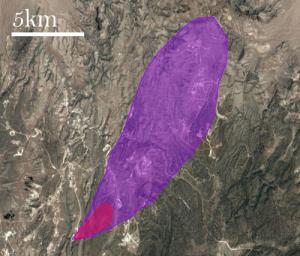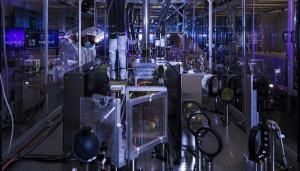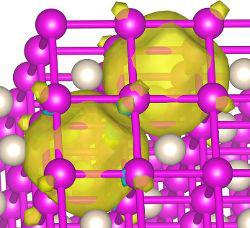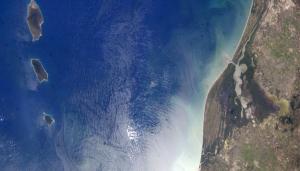LAB REPORT
Science and Technology Making Headlines
Feb. 10, 2017


The calculated spread of radionuclide Xe-133 from an underground nuclear explosion. Image by Matthew Simpson/LLNL
Noble detection
In 2006, North Korea conducted its first ever nuclear bomb test. Despite international condemnation, the nation proceeded to detonate four more bombs in the following decade.
A global effort to monitor radioactive particles, known as radionuclides, in the atmosphere is crucial to remotely identify such nuclear explosions, according to Jay Zucca, the principal deputy of the Global Security Directorate at Lawrence Livermore National Laboratory. Zucca presented an overview of nuclear explosion detection methods at a meeting of the American Physical Society, held in Washington, D.C. last week.
While seismic sensors can detect the unique waves that man-made explosions send rippling through the Earth, radioactive evidence is ultimately needed to verify a seismic event as a nuclear explosion.
"Even for successful containment of underground tests, it is expected that there'll be small releases of radioactivity, primarily noble gases," Zucca said.


HAPLS has set a world record for diode-pumped petawatt lasers, with energy reaching 16 joules and a 28 femtosecond pulse duration (equivalent to ~0.5 petawatt/pulse) at a 3.3 hertz repetition rate (3.3 times per second)
HAPLS lights the way
The High-Repetition-Rate Advanced Petawatt Laser System (HAPLS) being developed at Lawrence Livermore National Laboratory has set a world record for continuous operation of an all-diode-pumped, high-energy femtosecond petawatt laser system. The system is ready for delivery and integration at the European Extreme Light Infrastructure Beamlines (ELI Beamlines) facility project in the Czech Republic, where it will be used for conducting experiments.
In three years, HAPLS went from concept to a fully integrated, record-breaking product. HAPLS represents a new generation of application-enabling, diode-pumped, high-energy and high-peak-power laser systems with innovative technologies originating from the Department of Energy’s fusion laser research and development.
In the coming months, HAPLS will be transferred to ELI Beamlines, where it will be integrated into the facility’s laser beam transport and control systems, then brought up to full design specification — delivery of pulses with peak power exceeding 1 petawatt (quadrillion watts) firing at 10 hertz (Hz), breaking its own record and making it the world’s highest average power petawatt system. ELI plans to make HAPLS available by 2018 to the international science user community to conduct experiments using the laser.

An international group of scientists, including chemists from Lawrence Livemore, report helium can bond with sodium at high pressure. Credit: Ivan Popov/Utah State University
Helium yields to pressure
Can helium bond with other elements to form a stable compound?
Surprisingly, the standoffish element that on Earth is chemically inert and an unreactive compound that shuns connections with other elements and compounds reacts totally different under high pressure.
New findings by an international team including Lawrence Livermore’s Elissaios Stavrou found that under extremely high pressure like that found in Earth’s core or giant gas planet neighbors, helium’s chemistry is altered.
Through computations and experiments, the team found that sodium, never an earthly comrade to helium, readily bonds with helium under high pressure to form the Na2He compound.
Such knowledge raises big questions about chemistry and how elements behave beyond the world we know.


Lawrence Livermores’s Jeff Wisoff and Tammy Jernigan
Starstruck
You could say the stars were aligned when Jeff Wisoff was a Stanford grad student and introduced himself to undergrad Tammy Jernigan in the Physics Department. Soon after, they started dating.
They eventually wound up in NASA’s astronaut program. From 1991 to 1999, Jernigan flew five space shuttle missions, and from 1993 to 2000, Wisoff flew four, during which they ran experiments, tested jetpacks, launched satellites -- and admired the blue planet from space. Though the couple never explored that final frontier together, they took their own giant leap in 1999, when they got married in between missions.
After retiring from NASA, the couple -- each boasting a Ph.D. in physics -- took positions at Lawrence Livermore National Laboratory. They took on another great adventure a bit later: parenting. Wisoff and Jernigan spend much of their time with their two sons, attending basketball games and Boy Scout campouts.

This image, taken by an astronaut in early 2003, shows the land-sea interactions along a section of Mexico’s west coast just south of Mazatlan and the Isla Marias archipelago. The islands are a manifestation of intersecting plate boundaries.
It’s getting hot in here
The heat from Earth's core has a significant effect on tectonic plate movement.
The new research challenges the previous school of thought that movement of Earth's tectonic plates is driven largely by negative buoyancy created as they cool.
The team, including Lawrence Livermore National Laboratory scientist Nathan Simmons and university collaborators, combined observations of the East Pacific Rise (the Earth's dominant mid-ocean ridge) with insights from modeling of the mantle flow beneath the Pacific Ocean.
Researchers find the East Pacific Rise is dynamic as heat is transferred, showing that plate dynamics are driven significantly by additional force of heat drawn from Earth’s core.





